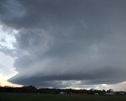Rick, a young roof mechanic, had worked for Clayton Roofing for almost a year and liked being part of a team.
One warm May morning, Rick and his co-workers were sent to install an asphalt shingle roof system. Rick was glad the weather had finally turned warmer. He was tired of the seemingly endless cold, gray winter days.
Steve, Clayton Roofing's foreman, had reviewed the job's potential safety hazards with the crew, including falls and how to avoid them.
The roof's slope was 8-in-12 (34 degrees), so slide guards were installed as work platforms. The workers donned personal fall-arrest systems and wore proper personal protective equipment. Access to the roof was provided by ladders, and Steve made sure the ladders were set on firm ground at the proper ratio: 1 foot away from the building for every 4 feet of eave height, extended 3 feet beyond the eave and securely tied-off.
The day was sunny, and the temperature soared. Steve reminded the workers to stay hydrated by drinking lots of water. A water cooler and disposable cups were provided on the ground. Rick didn't pay much attention to Steve's recommendation because he didn't feel especially thirsty.
At noon, the workers broke for lunch, finding some shade under a nearby tree. Rick, feeling lightheaded and not hungry, sat down and nibbled at his lunch.
After 45 minutes, the crew returned to work. Rick still felt lightheaded, but he continued to work, not wanting to slow down the crew.
Rick decided to take a break and get a drink of water. He climbed down the ladder and walked to the water cooler. Just as he reached the cooler, he lost his balance and stumbled. He fell, striking his head against the table on which the cooler sat.
Steve, who was standing by his truck using his cell phone, saw Rick fall and rushed over to him. Rick was unable to sit up and seemed disoriented. Above his right eye was a large gash where his head had hit the table edge.
Steve instructed Rick to stay on his back. He reached for a cup of water and helped Rick drink. Steve then called 911 and requested emergency help. Next, Steve called Mike, Clayton Roofing's owner, and reported what had happened.
The ambulance arrived, and Steve explained Rick's symptoms to the paramedics. His skin was cool, damp and pale. In addition, the cut on his head was still bleeding. The paramedics carefully moved Rick into the ambulance and drove to the hospital.
Mike met Steve at the hospital, and they spoke with Rick's doctor, who explained that Rick's symptoms—which included decreased blood pressure and delirium—were a result of dehydration. Fortunately, the cut on his forehead was not serious and required only a few stitches.
Dehydration symptoms, the doctor explained, usually are noticeable after about 2 percent of a person's normal water volume has been lost. The first symptoms to watch for are thirst and loss of appetite. Although Rick suffered moderate dehydration, the doctor said he was fortunate. Rick could have injured himself more severely had he fainted while climbing the ladder.
The doctor said that Rick could go home but should wait a day before returning to work. The doctor also recommended Mike talk to his workers about the steps to take to avoid dehydration and heat exhaustion.
Workers should take frequent breaks in cool areas on hot days, the doctor explained. They also should drink lots of fluids, especially water and fruit juices. The doctor recommended avoiding coffee and soda, which can dehydrate the body.
When Mike arrived at work the next day, he called a meeting with all employees and relayed the doctor's recommendations. Mike also suggested workers wear hats to deflect the sun's rays.
Later that day, Mike visited a job site to check on a crew. He was heartened—each worker wore a hat. As he walked around the job site, he also noticed there were several more water coolers and disposable cups. He was pleased to see the workers taking breaks and helping themselves to the water. Satisfied, he climbed back into his car and headed back to Clayton Roofing. He felt confident his workers would be safe throughout the long, hot summer.
Peter Greenbaum is owner of Chicago-based Tea Lake Productions and an NRCA media consultant.



